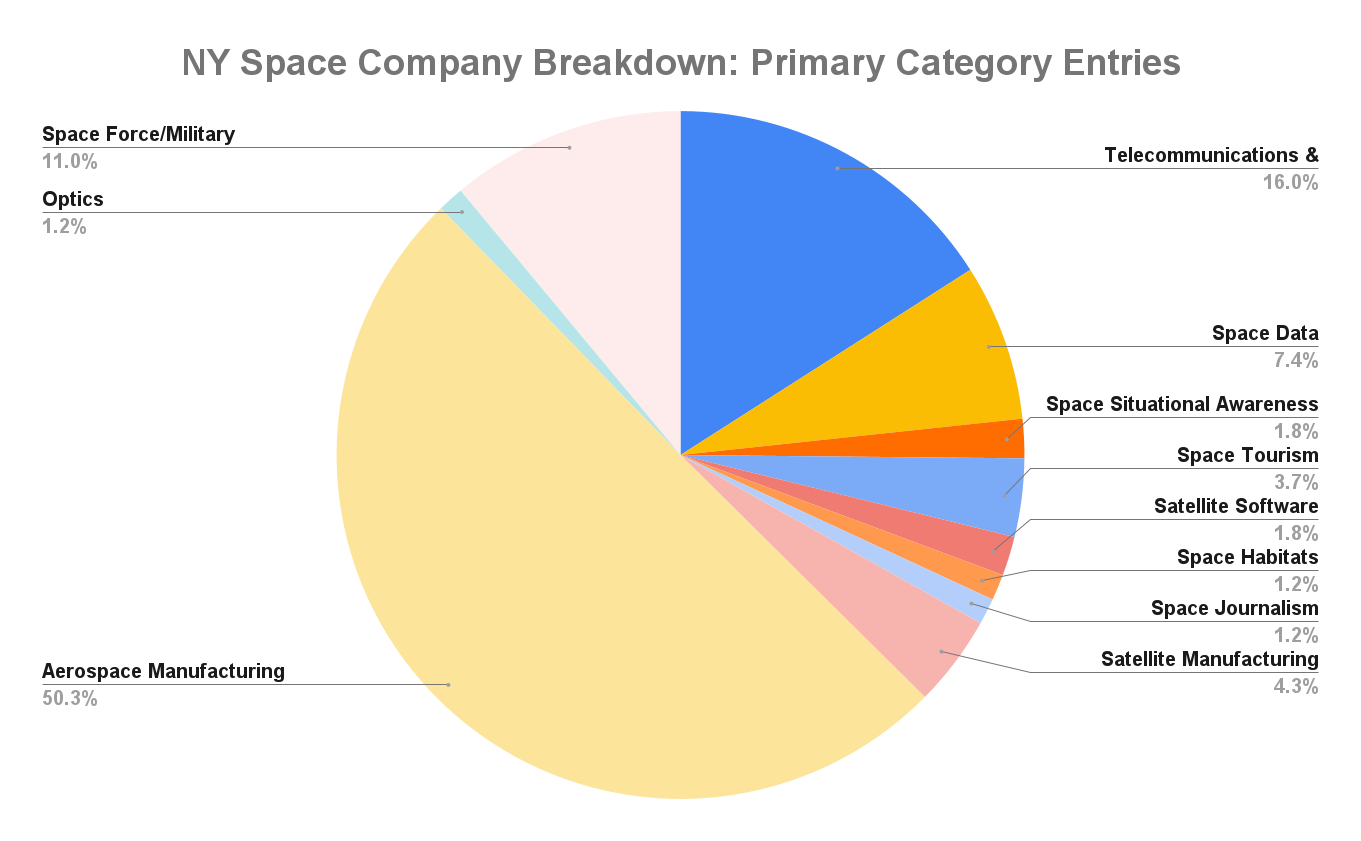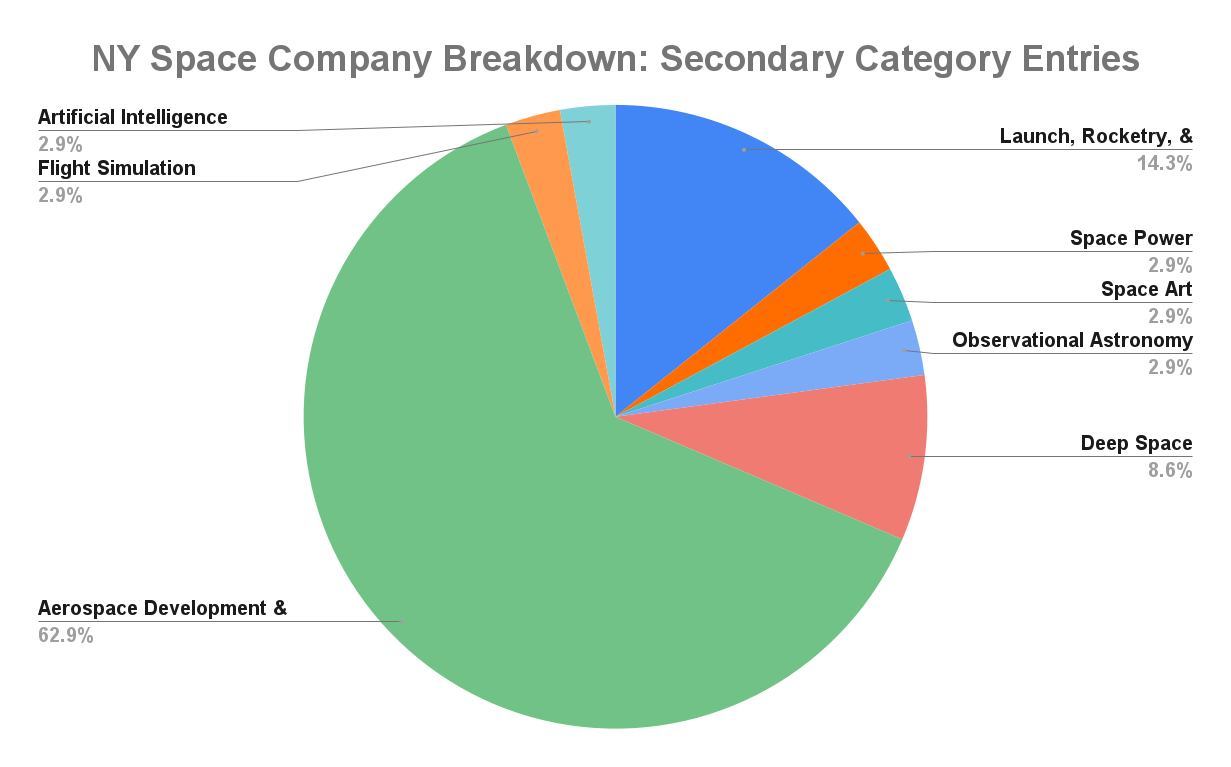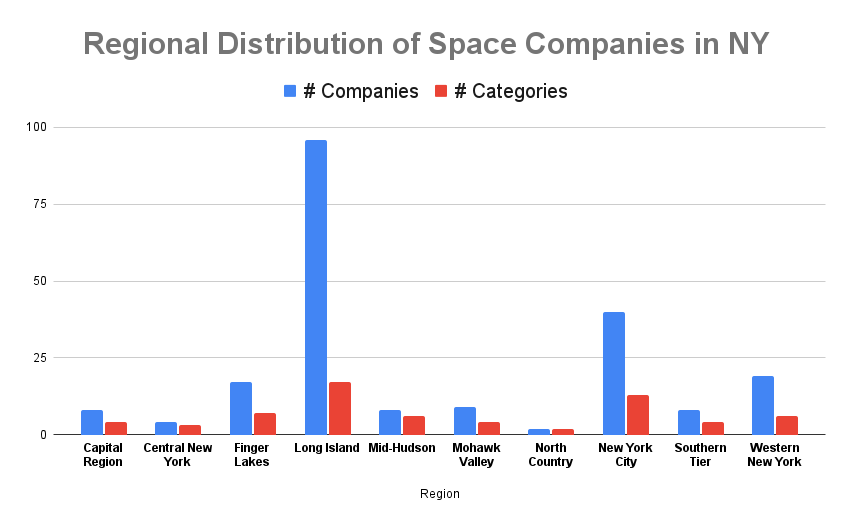
Please note a few quirks about these datasets. Space companies are only given one category, so while many companies conduct work in multiple fields, they are only represented in one. This also means there are several categories that appear to have no active entries, which is false, this work is just being conducted by companies with a different category designation.
Primary Categories - Primary sub-sectors targeted for enhanced focus & amplification. These are the foundational sources of potential growth in the New York space ecosystem. Many of these categories are already highly represented in the state, or should be primary areas of investment in the future. Below is a chart and then itemized list of the Primary Categories Empire Space has identified.

Telecommunications & Electronics: The business of utilizing space platforms and advanced electronics for developing, utilizing, or providing communications capabilities.
Earth imaging and remote sensing: The business of utilizing satellites to gather data and imagery about the Earth or other space objects for scientific, economic, and disaster response reasons.
Space Data: The business of acquiring or distributing space and geoscience data, including processing and geoanalytics.
GPS: Operations related to the numerous global GPS constellations, or more generally satellite operations related to positioning, navigation, and timing.
Space Situational Awareness: Space debris tracking and situational awareness software.
Satellite Servicing: Satellite refueling, deorbit, and other associating on-platform logistics.
Space Tourism: The business of sending paying private citizens into space in suborbital and orbital journeys. This includes firms that have licensed Virgin Galactic Travel Agents, or other certified space travel brokers.
Satellite Software: Satellite flight software, ground systems, and flight operations.
Quantum Space Applications: The business of identifying and developing space-based applications from the ever evolving quantum research sector, including secure communications.
Space Mining: The business of financing, developing, or facilitating resource extraction from non-terrestrial bodies including Near Earth Asteroids and the Moon.
Space Habitats: The business of designing, financing, developing, or manufacturing space/interplanetary habitats including the fields of agriculture, settlement, and terraforming.
Space Medicine: The research and practice of human physiology in space and ensuring astronauts remain healthy and safe.
Space Journalism: The business of creating written or visual content in service of promoting and amplifying human activity in space.
Space Finance: Technologies that support space-related commerce and investment and also the business of investing in space related enterprises.
Satellite Manufacturing: The business of designing, developing, and manufacturing satellites and their components.
Aerospace Manufacturing: The manufacturing and development of components for the aerospace sector, including machine shops and production factories.
Ground Support Equipment Manufacturing: The business of manufacturing the equipment necessary for the orbital ground support sector.
Space Law: The business of crafting or adjudicating the growing body of space law governing both domestic and international activities in Low Earth Orbit, the Moon, and beyond. This includes any efforts connected with UNOOSA.
Optics: The business of developing and producing advanced mirrors and optical devices for space-based purposes.
Space Education: Sector is devoted to educating and training anyone in K-college with the goal of participating in the space or aerospace sectors.
Space Force/Military: The business of supporting, supplying, or conducting research for the space-based applications of one or more branches of the US military, including Space Force.
Secondary Categories - Secondary sub-sectors still tracked and studied, but for various reasons are not major targets for growth in the New York space ecosystem. These are still active areas of investment in New York! However they are often either low-growth fields more generally or there are other external factors at play such as limitations in talent or resources. Below is a chart and then itemized list of the Secondary Categories Empire Space has identified.

Launch, Rocketry, Propulsion: The business of developing, manufacturing, or launching rockets or other space and aerospace propulsion systems, including interplanetary travel.
In-Space Manufacturing and Construction: The business of conducting research, manufacturing, or business on behalf of enterprises devoted to conducting manufacturing and construction in space, specifically Low Earth Orbit.
IoT in space: The business of investing and developing in the Internet of Things in space, in both remote and crewed applications.
Nuclear Space Applications: The study and development of opportunities to deploy nuclear power in space for both scientific and crewed missions, as well as nuclear propulsion applications and technologies for nuclear thermal and radiation environments.
Space Power: The business of researching and/or developing the ability to generate/distribute significant amounts of power in space.
Space Art: The ability to visually represent the power and majesty of space and our growing presence in it.
Observational Astronomy: Businesses related to the sale of telescopes, or otherwise connected to astronomical observing.
Deep Space: Relating to NASA or other space missions beyond Lunar orbit into “deep space.”
SETI & Astrobiology: Businesses relating to the search for extraterrestrial life, rudimentary or intelligent.
Aerospace Development & Support: The secondary aspects of the aerospace industry that include research, servicing, and management support.
Flight Simulation: Businesses focused on realistic simulations and other training protocols for pilots and/or astronauts.
Artificial Intelligence: The business of researching, developing, or utilizing Artificial Intelligence to explore space.
Private Aviation: The business of facilitating flight by private citizens in a tourist or training capacity.
Drones: Design, development, manufacturing, and applications for commercial and military drones. Can include VTOL and eVTOL.
Stratospheric Technologies: Design, development, manufacturing, and applications for stratospheric technologies, including balloons (e.g., weather, communications, imaging, and space tourism balloons).
Top 5 Categories:
Aerospace Manufacturing - 82 entries across 10 regions
Telecommunications & Electronics - 26 entries across 5 regions
Aerospace Development & Support - 22 entries across 7 regions
Space Force/Military - 21 entries across 4 regions
Space Data - 13 entries across 5 regions
Regional Breakdown

Every region in New York is home to at least two (2) different categories in the space economy, hosting active businesses and contributing to the economic and cultural fabric of their communities.
The Capital Region has 8 total entries across 4 categories.
Aerospace Manufacturing (5)
Deep Space Applications (1)
Space Art (1)
Space Engine Development (1)
Central New York has 4 total entries across 3 categories.
Aerospace Development & Support (2)
Aerospace Manufacturing (1)
Space Data (1)
The Finger Lakes Region has 17 total entries across 7 categories.
Aerospace Manufacturing (4)
Deep Space Applications (1)
Optics (1)
Satellite Manufacturing (1)
Space Situational Awareness (1)
Space Tourism (1)
Telecommunications & Electronics (8)
Long Island has 96 total entries across 17 categories.
Aerospace Development & Support (14)
Aerospace Manufacturing (40)
Artificial Intelligence (1)
Flight Simulation (1)
Launch, Rocketry, & Propulsion (2)
Optics (1)
Private Aviation (1)
Satellite Manufacturing (4)
Satellite Software (1)
Space Data (2)
Space Education (3)
Space Force/Military (11)
Space Journalism (1)
Space Power (1)
Space Situational Awareness (1)
Space Software (1)
Telecommunications & Electronics (11)
The Mid-Hudson Region has 8 total entries across 6 categories.
Aerospace Development & Support (1)
Aerospace Manufacturing (3)
Observational Astronomy (1)
Satellite Manufacturing (1)
Space Education (1)
Telecommunications & Electronics (1)
The Mohawk Valley has 9 total entries across 4 categories.
Aerospace Manufacturing (4)
Launch, Rocketry, & Propulsion (1)
Space Force/Military (2)
Telecommunications & Electronics (2)
The North Country has 2 total entries across 2 categories.
Aerospace Development & Support (1)
Aerospace Manufacturing (1)
New York City has 40 entries across 13 categories.
Aerospace Development & Support (1)
Aerospace Manufacturing (14)
AI (1)
Launch, Rocketry, & Propulsion (1)
Private Aviation (1)
Satellite Manufacturing (1)
Satellite Software (2)
Space Data (6)
Space Habitats (2)
Space Journalism (1)
Space Situational Awareness (1)
Space Tourism (5)
Telecommunications & Electronics (4)
The Southern Tier has 8 total entries across 4 categories.
Aerospace Development & Support (1)
Aerospace Manufacturing (3)
Space Data (2)
Space Force/Military (2)
Western New York has 19 total entries across 6 categories.
Aerospace Development & Support (2)
Aerospace Manufacturing (7)
Launch, Rocketry, & Propulsion (1)
Space Data (2)
Space Force/Military (6)
Space Habitats (1)
Summary
New York is home to a vibrant and diverse space economy with a wide variety of companies active across the state. Every region is home to at least a slice of this activity, with some regions possessing highly specialized and diversified space sectors. The primary sub-sectors in the state are aerospace, telecommunications, space data, and space force/military related enterprises.
All of this serves to highlight a few key points:
1. New York currently has an active space economy, employing thousands of New Yorkers in every corner of the state.
2. This space economy is diverse, with multiple sub-sectors represented.
3. This space economy represents all of New York, with all 10 regions represented and many regions in disparate areas of the state home to large and diverse space economies.
This all serves to highlight the reality that New York is already a great destination for investment in space, and is well positioned to grow in multiple industries as the global space economy explodes throughout the rest of the 21st century.